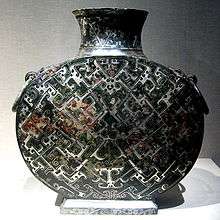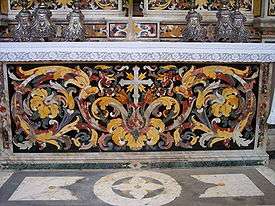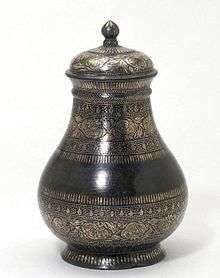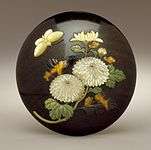Inlay

Inlay covers a range of techniques in sculpture and the decorative for inserting pieces of contrasting, often coloured materials into depressions in a base object to form ornament or pictures that normally are flush with the matrix.[1] A great range of materials have been used both for the base or matrix and for the inlays inserted into it.
In wood


In a wood matrix, inlays commonly use wood veneers, but other materials like shells, mother-of-pearl, horn or ivory may also be used. Pietre dure, or coloured stones inlaid in white or black marbles, and inlays of precious metals in a base metal matrix are other forms of inlay. Master craftsmen who make custom knives continue a tradition of ancient techniques of inlaying precious metals; additionally, many new techniques which use contemporary tools have also been developed and utilized as well by artisans.
Intarsia inlay in wood furniture differs from marquetry, a similar technique that largely replaced it in high-style European furniture during the 17th century,[2] in that marquetry is an assembly of veneers applied over the entire surface of an object, whereas inlay consists of small pieces inserted on the bed of cut spaces in the base material, of which most remains visible.
Uses
Inlay is commonly used in production of decorative furniture, where pieces of coloured wood or metal are inserted into the surface of the carcass. Lutherie inlays are frequently used as decoration and marking on musical instruments, particularly the smaller strings.
The most famous example of furniture inlay in Europe may be the late 15th century Studiolo made for Federico da Montefeltro in his Ducal Palace at Urbino, in which trompe-l'oeil shelving seems to carry books, papers, curios and mathematical instruments, in eye-deceiving perspective. The similar private study made for him at Gubbio is now in the Metropolitan Museum of Art (illustration).[3]
Metal
The history of inlay is very old. The technique of metal in metal inlay was sophisticated and accomplished in ancient China as es of vessels decorated with precious metals including this ding vessel (pictured) with gold and silver inlay from the Warring States period (403-221 BC).
After learning the skill of smithing from the Navaho in 1872, the Zuni silversmiths cut small chips from crystals and gemstones, pearl shell and coral, to make inlay designs in a base of silver.
The French cabinet maker Andre-Charles Boulle (1642-1732) specialized in furniture using inlays or metal and either wood or tortoiseshell together, the latter acting as the background.
Stone
Pietra dura is the usual term in Europe for detailed inlays in contrasting colours of stones, including many semi-precious types; parchin kari is an Indian term. Pietra dura developed from the Roman Opus sectile, which was typically used on a larger scale, especially in floors. Cosmatesque work on walls and floors, and smaller objects, was a medieval intermediate stage, continuing ancient opus alexandrinum.
Inlaid artefacts have come down to us from the Ancient Mayan civilisation, among them, jade, mother of pearl and onyx inlaid into stone during the era that arts reached a peak during the seven centuries from 200 to 900 AD.
Kinds of inlay
 Pre-Dynastic Egyptian bone figure with eyes inlaid in lapis lazuli; inlaid eyes are found in sculpture from many periods
Pre-Dynastic Egyptian bone figure with eyes inlaid in lapis lazuli; inlaid eyes are found in sculpture from many periods Decaying wood inlay on a chest in a Greek monastery.
Decaying wood inlay on a chest in a Greek monastery.- Ding bronze vessel with gold and silver inlay (Damascening) from the Warring States period (403-221 BC) of ancient China. (c. 300 BC)
 Egyptian bone plaque of a putto, with wax inlay, 4th century
Egyptian bone plaque of a putto, with wax inlay, 4th century Geometric figure (1537) in wood intarsia by Fra Damiano da Bergamo, Bologna, Italy
Geometric figure (1537) in wood intarsia by Fra Damiano da Bergamo, Bologna, Italy- Parchin kara (pietra dura) in stone on the Taj Mahal
- Wooden box with inlaid ivory, Royal Ontario Museum, Toronto
- Marquetry casket, Ottoman Empire (Istanbul or North Africa), 17th-18th century, wood, tortoise shell, bone, ivory inlay

 Japanese netsuke in ivory with ink; the eyes are inlaid in shell. 19th century
Japanese netsuke in ivory with ink; the eyes are inlaid in shell. 19th century.jpg) Egyptian basin with silver inlay
Egyptian basin with silver inlay
(Walters Art Museum) Japanese Photograph Album Cover with ivory inlay, 1865
Japanese Photograph Album Cover with ivory inlay, 1865 Japanese: late 19th century, wood with ivory, tortoiseshell, mother-of-pearl inlays; manjū type
Japanese: late 19th century, wood with ivory, tortoiseshell, mother-of-pearl inlays; manjū type
See also
Notes
- ↑ Oxford Companion to the Decorative Arts, 1975, s.v. "Inlay", "Wood-working (Special Techniques)".
- ↑ John Fleming and Hugh Honour, The Penguin Dictionary of Decorative Arts (1977) s.v. "Inlay".
- ↑ Metropolitan Museum: Studiolo
External links
| Wikimedia Commons has media related to Inlay (art). |
- Contemporary Wall Art Marquetry - New technics
- Luigi Nebuloni's Personal Page Modern inlay painting
- Difference between Indian Classic Inlay and Italian Pietra Dura "Parchinkari"
- Taraceas Spanish wood inlays